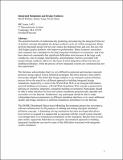| dc.description.abstract | The potential benefits of mathematically predicting and analyzing the integrated behavior
of product concepts throughout the design synthesis cycle are widely recognized. Better
up-front integrated design will not only reduce development time and cost, but also will
yield higher quality products with improved performance. Many academic researchers
and companies have attempted to develop integrated simulation environments, and it has
been observed consistently that significant difficulties arise because of the large scale,
complexity, rate-of-change, heterogeneity, and proprietary barriers associated with
product design synthesis. However, the focus of most integration efforts has been on
enabling technology, while the process of how integrated systems are constructed has not
been questioned.
The literature acknowledges that it is very difficult to represent and structure emergent
processes using explicit system definition techniques like those that have been almost
universally adopted. The belief that design synthesis is an emergent system definition
process drives the search for a different approach to building integrated design
simulations. Inspired by a vision of the World-Wide Web as an emergent informationnetwork
building environment, a World-Wide Simulation Web concept is proposed for
defining an emergent, integrated, simulation-building environment. Participants should
be able to make interfaces to local sub-system simulations parametrically operable and
accessible over the Internet. Furthermore, any participant should be able to make
relationships between parameters in different simulation interfaces or to create additional
models that bridge interfaces to different simulations distributed over the Internet.
The DOME (Distributed Object-based Modeling Environment) project has developed a
software infrastructure for the purpose of refining and testing emergent simulation
definition concepts. A federating solving mechanism has been developed that allows
local solvers to respond in a manner that is consistent with the overall system structure
even though there is no centralized coordination of the simulation. Results from several
pilot studies support the belief that an emergent, decentralized approach to building
integrated simulations can resolve many of the difficulties associated with integrated
system simulation. | en |
